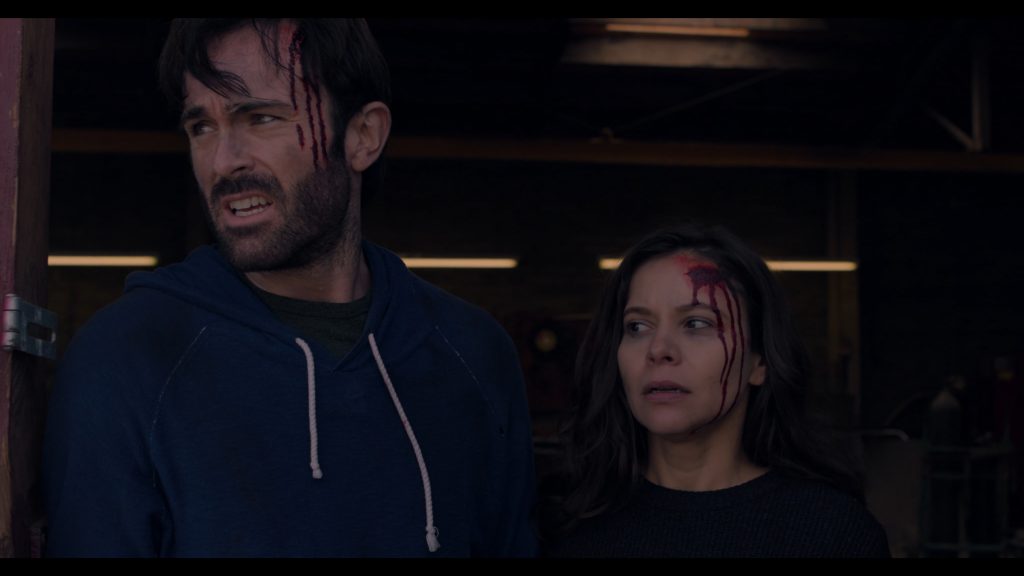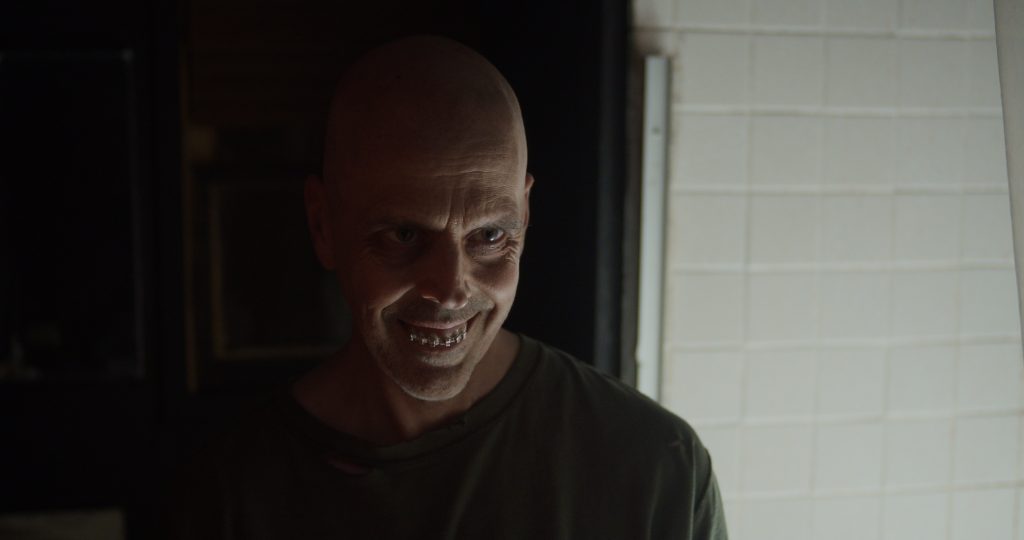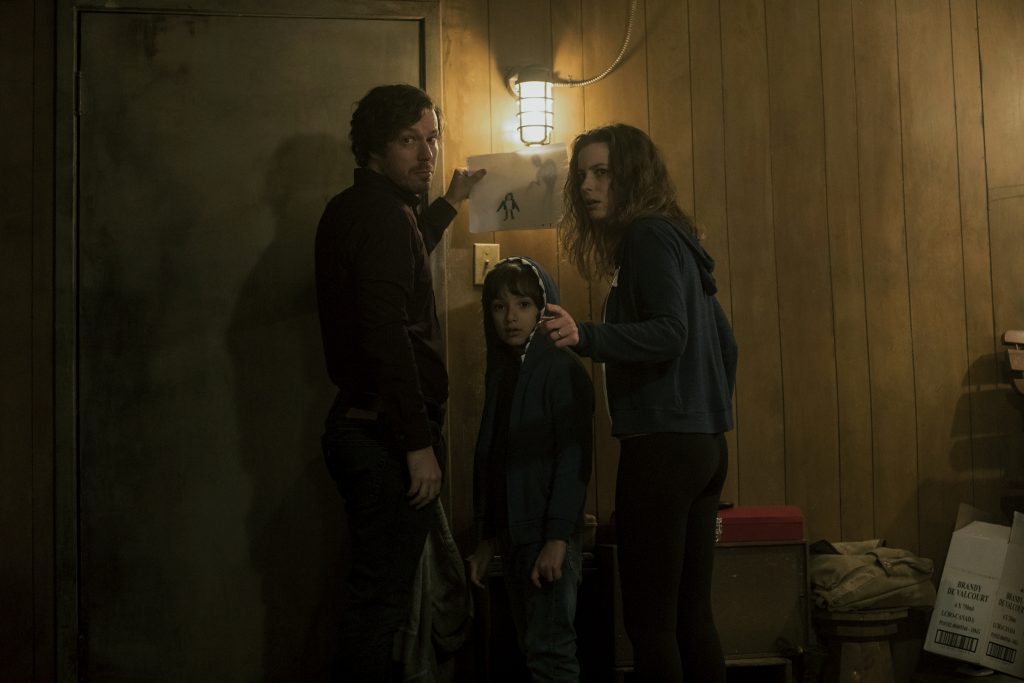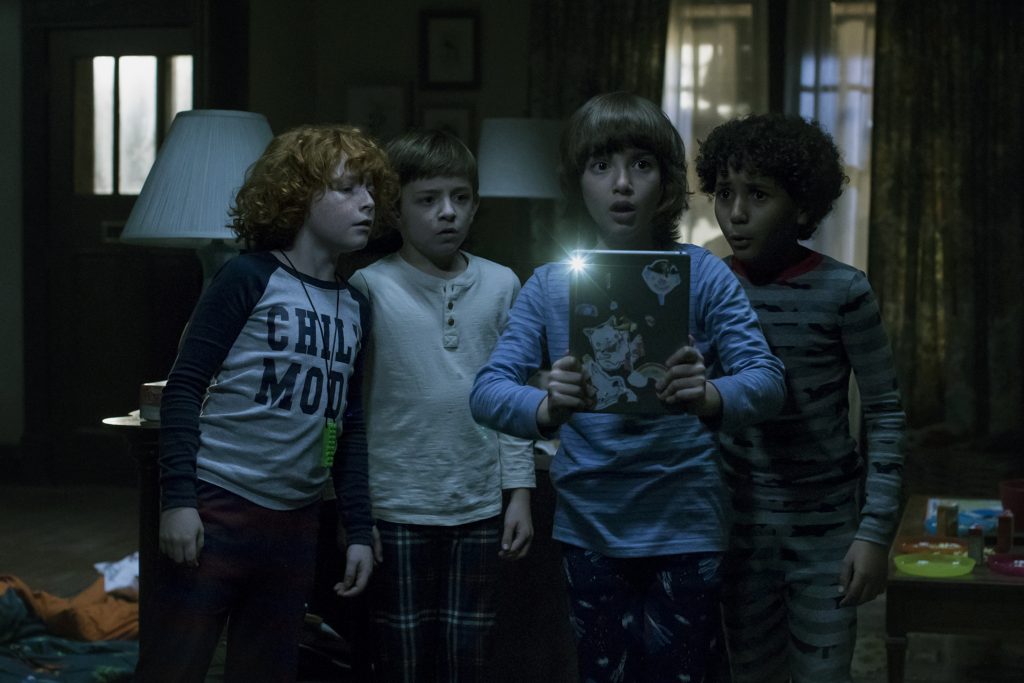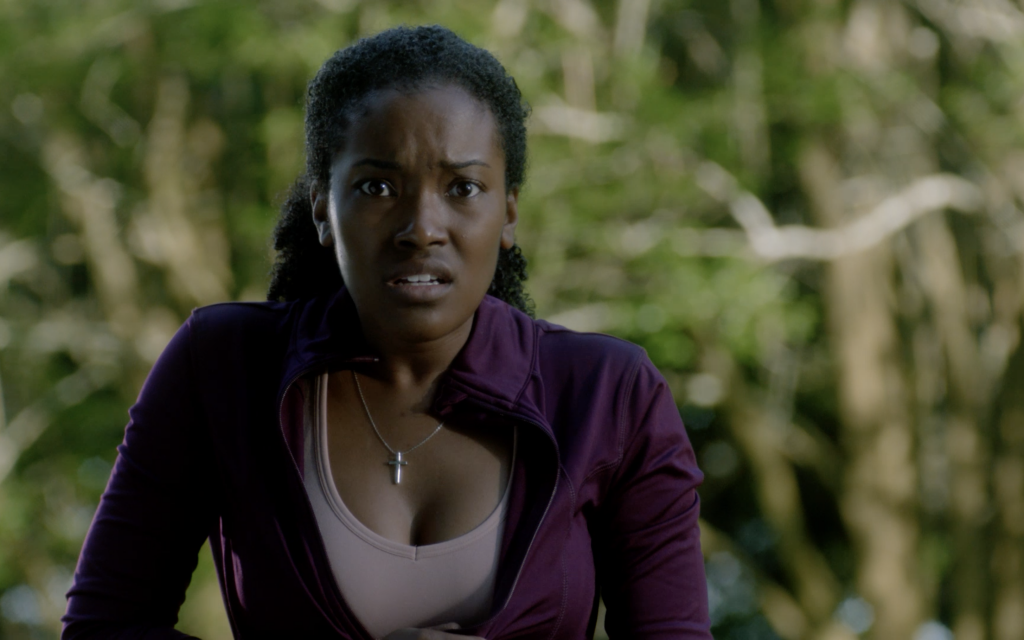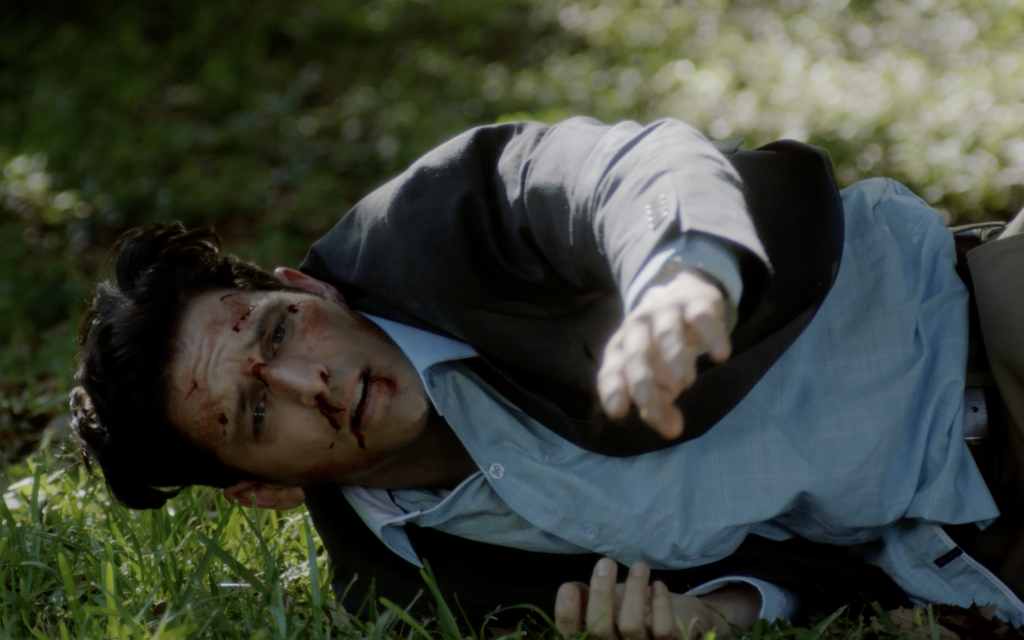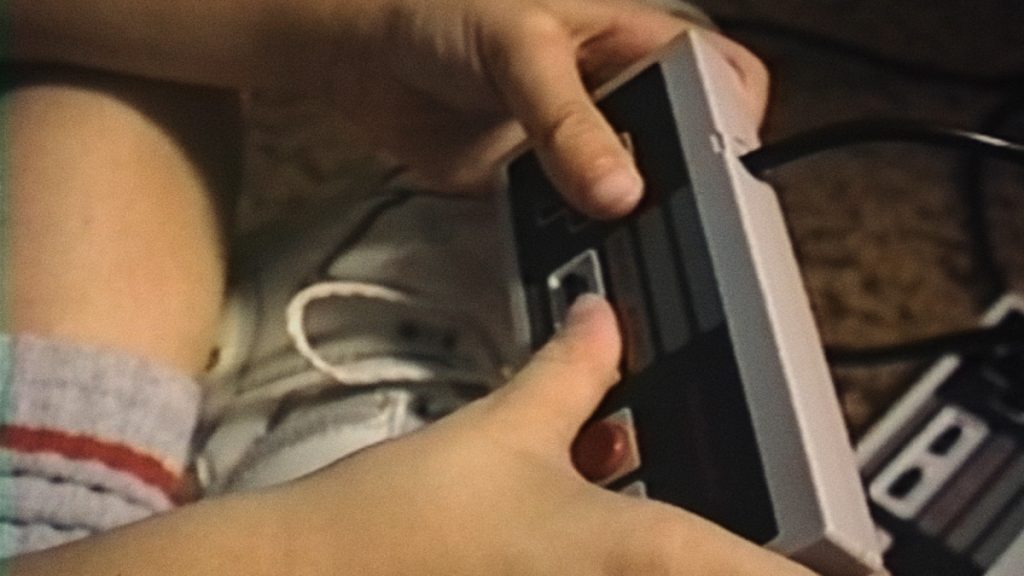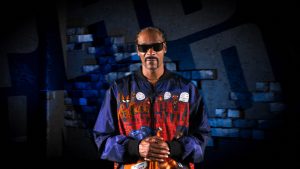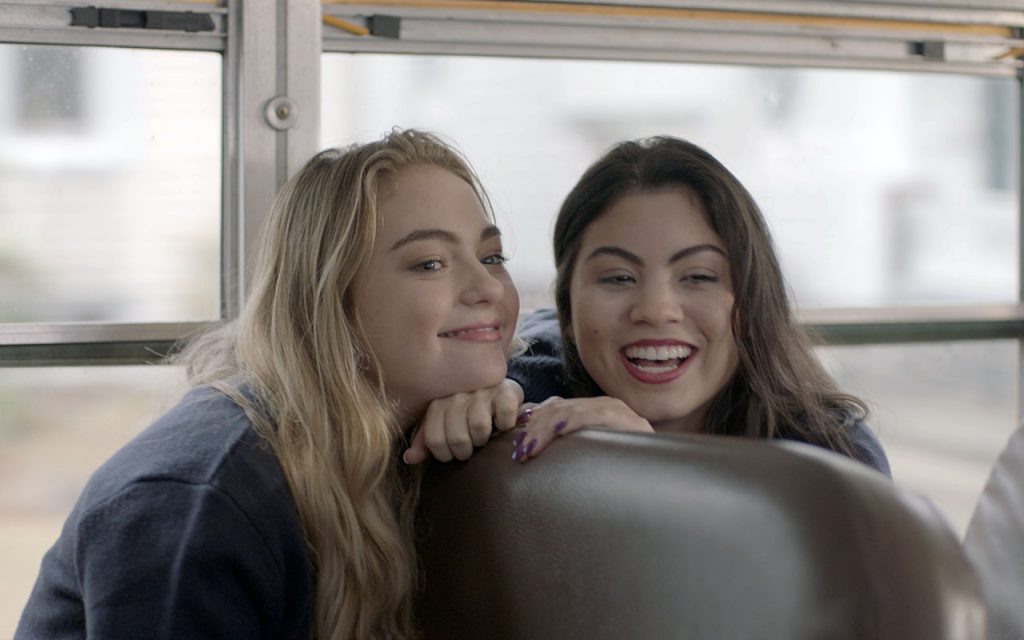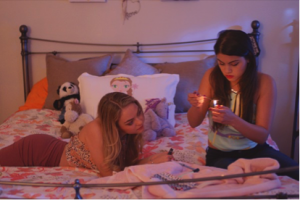October 30, 2020
by Carla Hay
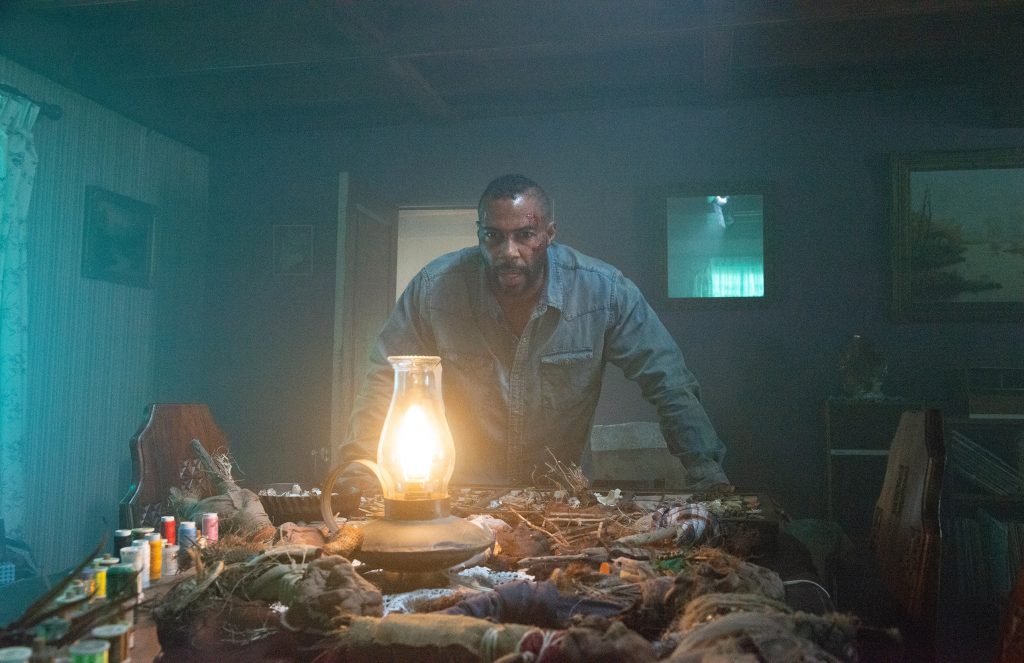
Directed by Mark Tonderai
Culture Representation: Taking place primarily in the rural Appalachian area of West Virginia, the horror flick “Spell” has a predominantly African American cast of characters (with a few white people) representing the poor, middle-class and upper-middle-class.
Culture Clash: After a plane crash, an attorney who’s a family man finds himself held captive by a hoodoo priestess who uses body parts for her potions.
Culture Audience: “Spell” will appeal primarily to people who like to see gory movies with voodoo/hoodoo themes, but the movie has too many dumb plot holes to be considered a quality story.

The horror movie “Spell” has an interesting social theme that is rarely seen in narrative films: The class divide and prejudices that can exist between African Americans who are upper-middle-class and African Americans who have less financial advantages. Unfortunately, this theme, which could have made “Spell” a more interesting film, is squandered and buried in order to go to down yet another predictable and gory horror path. Even the suspenseful scenes are badly handled with plot holes that ruin any credibility that “Spell” hoped to have.
Directed by Mark Tonderai and written by Kurt Wimmer, “Spell” begins with the introduction of the family who will be involved in the fateful plane crash that sets off this movie’s horror. Marquis T. Woods (played by Omari Hardwick) is a successful corporate attorney working in an unnamed big city in the United States. He’s well-respected by his boss Wyman Thatcher (played by Andrew Jacobs) at the law firm.
Marquis is a very tough and very competitive lawyer who doesn’t let the fact that he’s African American get in the way of wanting to win a case if the opponents are also African American. During a conversation between Wyman and Marquis, they discuss a class-action lawsuit where the plaintiffs are African American and the plaintiffs’ attorneys are white. The law firm that Marquis works for is representing the defendants in the lawsuit, and Marquis is the lead attorney in the case.
The exact details of the lawsuit aren’t revealed in the story, but it’s implied that it has to do with accusations of racial discrimination. In other words, Marquis doesn’t really care if people might think of him of being a “race traitor” for representing the defendants in this case. He just wants to win.
He might be a ruthless attorney in the courtroom, but at home, Marquis is a loving and loyal family man with a disciplinarian streak and hints of being a control freak. The movie opens with a somewhat odd scene of Marquis’ wife Veora Woods (played by Lorraine Burroughs) accidentally locked in their bedroom. She pleads with Marquis, who’s on the other side of the door, to break down the door and let her out. He refuses because he says the door cost $1,500.
As a prank, Marquis pretends that he can’t do anything to help her, and he says that he’s going to call a locksmith. It could take more than an hour for a locksmith to come over and break the lock and then replace it. Veora says she doesn’t have that kind of time.
After some more begging and pleading from Veora, Marquis finally puts Veora out of her misery and uses a pin to unlock the door. She rushes out with relief, but she’s slightly irritated that Marquis would put her in this uncomfortable situation as a joke. It shows a manipulative side to Marquis that may not be violent, but it demonstrates how he might get some pleasure out of seeing people squirm.
Therefore, it comes as no surprise that Marquis has an abusive past. When he was a child, his father often beat, tortured and emotionally abused Marquis, who is so haunted by these memories that he still has nightmares about the abuse. (In flashback scenes, Ri-Karlo Handy plays Marquis’ father, while twins Bodhi Tonderai-Hodges and Sahara Tonderai-Hodges portray Marquis as a child.)
Marquis also grew up very poor in the Appalachian area of West Virginia. It’s a past that he left behind 25 years ago and doesn’t want to go back to anytime soon. Marquis hasn’t lied about his personal history of growing up poor and abused, but he’d rather forget that it happened. And it fuels his drive to be as wealthy and successful as possible.
That’s why he’s instilled in his teenage kids—son Tydon “Ty” Woods (played by Kalifa Burton) and daughter Samsara “Sam” Woods (played by Hannah Gonera)—who are both in their mid-teens, a strong sense of wanting them to become high achievers. But with that ambition also comes a certain snobbery where Sam and especially Ty look down on people who are poor and unsophisticated. Ty doesn’t hesitate to call other black people the “n” word if he thinks they’re of a lower class than he is. When Veora hears Ty use this racial slur, she scolds him and tells him that she doesn’t want him to use that language.
In another scene, Veora tells Marquis in front of their kids that she’s worried about the children turning into entitled jerks. Marquis responds by saying, “If I had my way, your son and daughter will spend their lives in a boardroom, not in some jungle I couldn’t get out of fast enough.” Veora says, “Except sometimes, Marq, that jungle comes back to find you, no matter what boardroom you’re hiding in.”
This conversation takes place on a private single-engine, four-seat plane that Marquis is piloting, with Veora, Ty and Sam as the passengers. They are on the plane because Marquis has been notified that his father has died, and the family is going to back to Marquis’ hometown in West Virginia for the funeral and to take care of some other matters related to the death.
Marquis makes a pit stop in a rural area at a small-strip gas station with a convenience store. An elderly man (played by Leo Wringer) who works at the gas station and a young man (played by Tafara Nyatsanza) who happens to be there too are exactly the type of “country” African Americans who make Marquis and Ty uncomfortable. Ty doesn’t do much to hide his condescension, while these two local men think that Marquis and his family are stuck-up city folks.
Marquis and his family aren’t at the gas station for long, when the local sheriff (played by Tumisho Masha) pulls up to find out why this small plane has landed in his jurisdiction. Marquis reminds the sheriff that it’s legal for him to land there, since it’s a single-engine plane. Marquis also shows his pilot license and tells the sheriff why they’re at the gas station. The sheriff is friendly but a little wary of these newcomers.
After the plane is back in the air, a massive storm hits and the plane looks like it’s in danger of crashing. The crash is actually never shown in the movie. The next thing that happens is that Marquis wakes up in a bed in a house attic, with a head injury and his left foot bleeding and bandaged. Where is he and what happened to his family?
Marquis finds out that he’s being held captive at a farmhouse by a woman named Eloise (played by Loretta Devine), a demented voodoo priestess who has a dual persona of being a friendly “church lady” and a wicked witch. Her mood swings are unpredictable, but largely based on whether or not she thinks she’s in control of a situation. She can get menacing very quickly if she thinks Marquis is trying to escape.
Eloise tells Marquis that he was found in the plane crash, and she insists that no one else was with him. Marquis doesn’t quite believe her and he desperately wants to escape and find his wife and kids. Eloise, who calls herself a “root worker,” says that she doesn’t believe in a lot of technology and inventions, such as phones, computers, radios and television.
The rest of the movie is basically a series of attempted escapes by Marquis, who finds out that Eloise uses body parts (human and animal) for her potions and spells. She tells Marquis she can nurse him back to health with the Boogity, a hoodoo doll that she has made from his skin and blood. She blows powdered potion in Marquis’ face to drug him. And later, Marquis witnesses a revival meeting with Eloise working her magic on some local people with disabilities.
Ms. Eloise has two accomplices who help her keep Marquis captive on her run-down farm: Earl (played by John Beasley), who seems to be Eloise’s love partner/common-law-husband, and a hulking handyman named Lewis (played by Steve Mululu), who looks like he’s strong enough to permanently injure someone with his bare hands. Miss Eloise says of Lewis, “People think he’s slow, but there’s nothing slow about him.”
Later, when Marquis asks Eloise if she really believes in the hoodoo that she practices, she responds in an irritated tone, “I guess I have to. We don’t have much in the way of Obamacare around here.” She also responds to Marquis’ obvious condescension toward her beliefs and lifestyle: “You a city boy. You better than all of this.”
There are a few moments where “Spell” goes from being a mildly interesting horror movie to being a disappointing dud with too many plot holes to ignore. The first big nonsensical moment comes when Marquis gets a chance to run away and escape, but instead he sticks around to watch one of Eloise’s revival gatherings. The second and more improbable scenario that plays out is when Marquis removes a very long nail from his injured foot (the nail is so long that it would definitely destroy tendons) and then shoves it back in his foot, for reasons that are shown in the movie.
What’s ludicrous about these scenes with Marquis removing the nail and then putting it back in his foot, is that in real life, he would go into medical shock if he performed those procedures on himself and would most likely pass out from the shock and infections. And yet, he’s still able to run around (with a limp) before and after this self-surgery. It can’t be stressed enough that this is not a tiny nail. The nail is almost as long as his foot. The only reason to have these unrealistic scenes of Marquis removing the nail and slamming it back in his foot is to just have a gross-out scene that people will remember about this movie.
As for the acting in “Spell,” Devine at least seems to be having some fun hamming it up in this role as the unhinged hoodoo priestess Eloise. However, there’s absolutely no real backstory for this character (there’s only a small hint), and Eloise ends up being a generic villain after a while. In fact, all of the characters are fairly generic, as are most of the performances in this movie. There are hints of Marquis’ complicated and traumatic personal history, but any further exploration of his troubled past is largely abandoned when the rest of the story becomes about his kidnapping ordeal.
“Spell” needed to bring something fresh and creative to the story, considering that the 1990 Oscar-winning horror film “Misery” already set a gold standard for a movie about a man held captive by an evil woman who does something awful to his legs. The ending of “Spell” is very unimaginative, predictable and feels too rushed. The movie’s production design and cinematography are very effective, but the screenplay and overall direction lack the spark, cohesiveness and personality that are needed to make a better-than-average film. The good news for people turned off by “Spell” is that it’s highly unlikely to get a sequel.
Paramount Pictures released “Spell” in select U.S. cinemas, on digital and on VOD on October 30, 2020.

